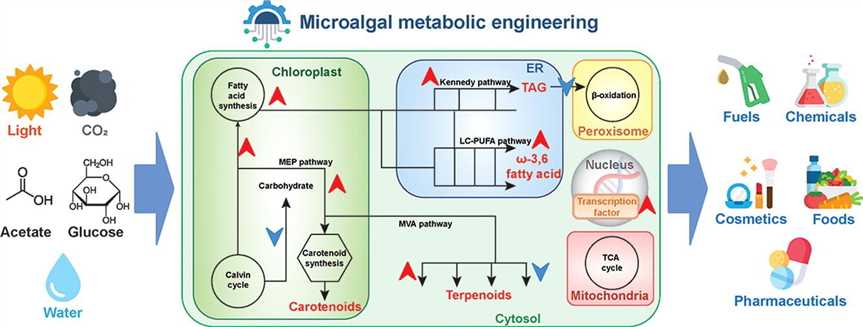Microalgae are unique phototrophic cell factories that convert CO2 and carbon-containing organic matter into primary and secondary metabolites. Increasing the productivity of these metabolites can lead to new drugs, nutrients, and industrial applications. Here, Lifeasible offers specialized solutions for the genetic engineering of microalgal metabolites.
Microalgae are considered the most promising feedstock for metabolite production due to their high growth rate, biomass production, and ease of cultivation. The primary metabolites of microalgae (carbohydrates, proteins, and lipids) are the key compounds essential for the organism's survival. Secondary metabolites are compounds (pigments, alkaloids, isoprenoids, fungal-like amino acids (MAA), sterols) involved in defense mechanisms, stress responses, signaling, etc. These metabolites are widely used in biorefining methods to produce commercially viable drugs, nutraceuticals, or cosmeceuticals. However, under natural conditions, intracellular metabolite production rate is insufficient for large-scale production. Researchers have explored altering the inherent metabolic capacity of microalgae to produce more primary and secondary metabolites by genetically engineering the delivery of foreign genetic material into algal cells.
 Fig 1. Microalgal metabolic engineering strategies for the production of fuels and chemicals. (Kang N K, et al., 2021)
Fig 1. Microalgal metabolic engineering strategies for the production of fuels and chemicals. (Kang N K, et al., 2021)
Our skilled scientists employ various genetic engineering tools and multi-omics analyses to enhance the productivity of microalgal metabolites. Lifeasible is committed to transforming microalgal genomes to overexpress microalgal target genes to enhance the production of desired metabolites or to re-engineer them using synthetic biology. We offer genetic transformation of the following microalgal metabolites.
Based on our cutting-edge microalgal metabolic pathways and metabolic engineering strategies, we develop customized processes for producing microalgal metabolites using genetic engineering.
(1) Screen cells based on growth rate and higher productivity.
(2) Perform transcriptome analysis to select targets.
(3) Design editing tools and translate genes of interest into target loci.
(4) The selected transformants with the desired traits are used for histological analysis and profiling to identify any new metabolites or directly for large-scale culture and expression studies.
To ensure higher yields of target microalgal metabolites, we have several transformation techniques to insert exogenous genes into the nuclear or chloroplast genome.
At Lifeasible, we can quickly help you increase the productivity and efficiency of microalgal metabolites based on the metabolic engineering of microalgae, creating a more sustainable and cost-effective production platform. We are your trusted partner in all aspects of microalgae research. If you are interested in our solutions for the genetic engineering of microalgae for metabolite production, please do not hesitate to contact us.
Reference
Lifeasible has established a one-stop service platform for plants. In addition to obtaining customized solutions for plant genetic engineering, customers can also conduct follow-up analysis and research on plants through our analysis platform. The analytical services we provide include but are not limited to the following:
STU-CRISPR System Improves Plant Genome Editing Efficiency
April 19, 2024
Application of Exosomes in Facial Beauty
April 12, 2024